Photos with this report (click to enlarge) | |||
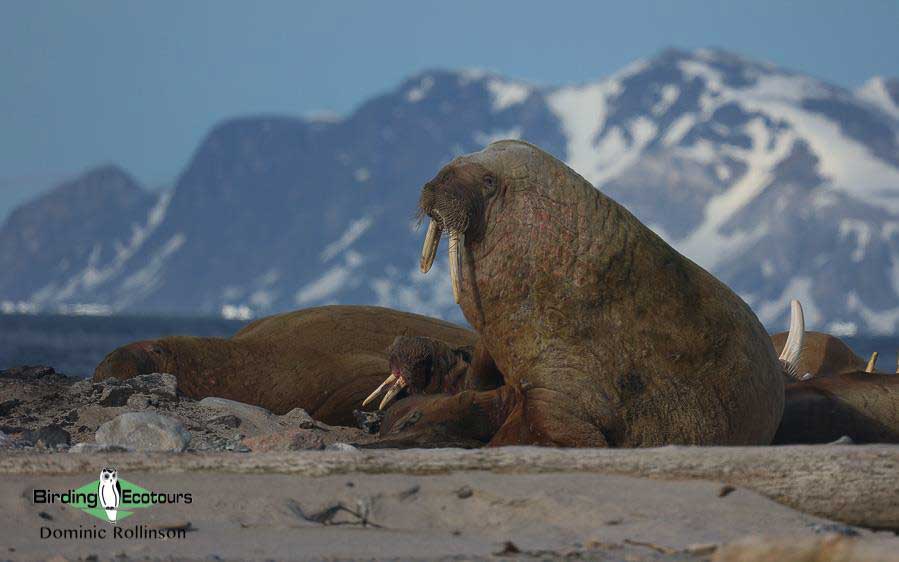 Walrus |
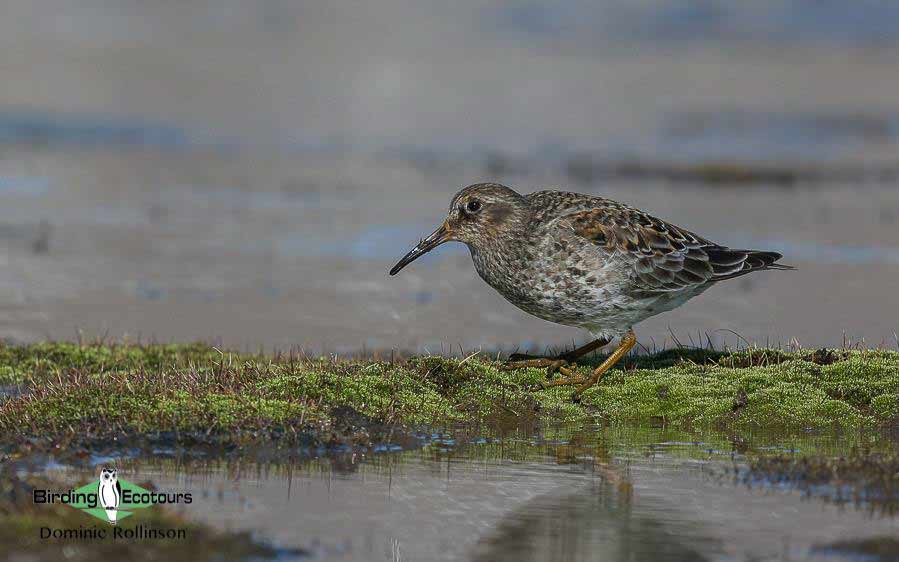 Purple Sandpipers |
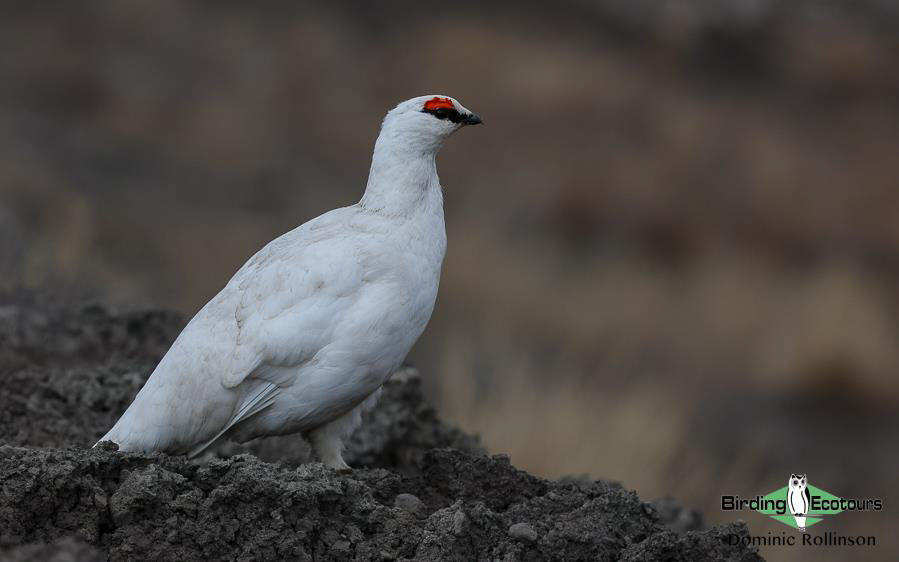 Rock Ptarmigan |
|
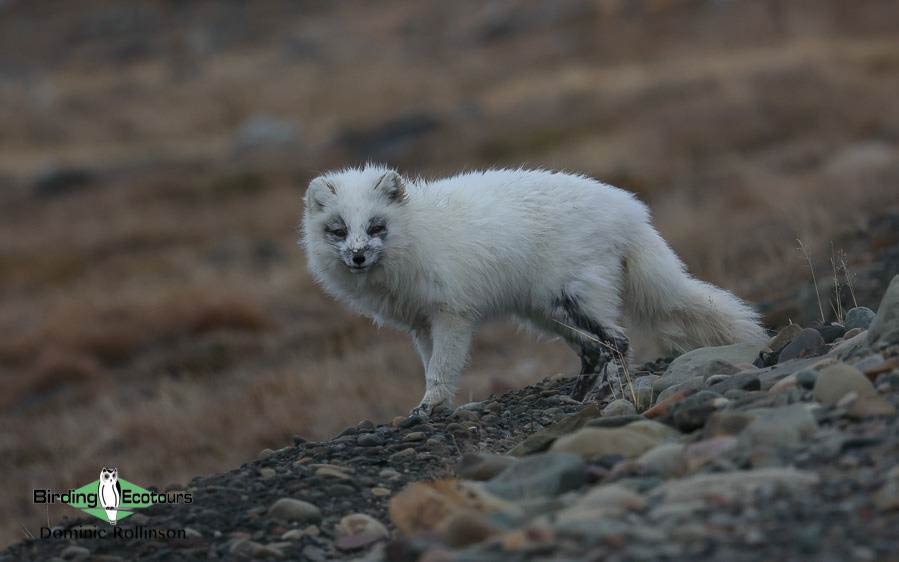 Arctic Fox |
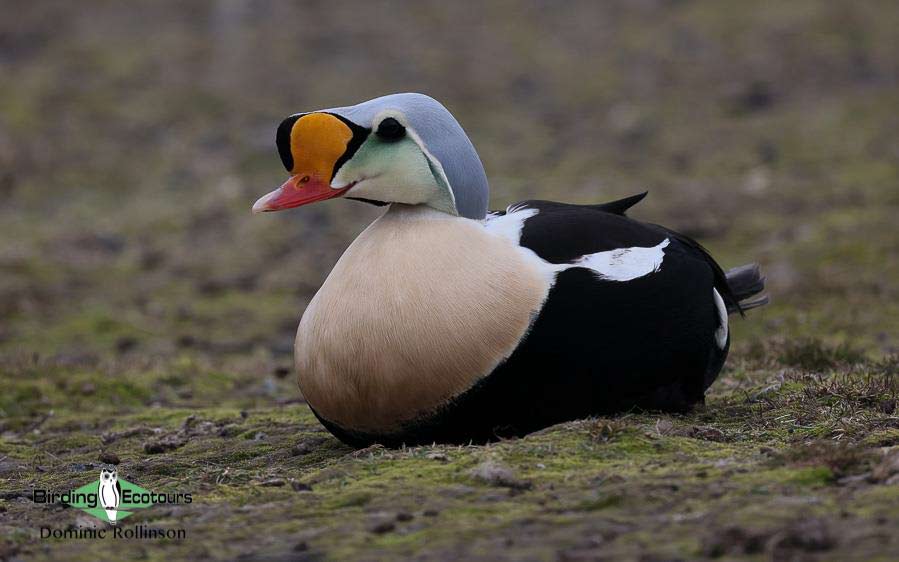 King Eider |
||
Overview
A Svalbard birding and mammal cruise is a trip like no other and delivers a fantastic selection of iconic Arctic birds and wildlife. Our cruise left from Longyearbyen (Spitsbergen) in the Svalbard Archipelago (part of Norway) and we spent a week exploring the area’s many scenic fjords and vast pack ice. In the Arctic, the name of the game is ‘quality over quantity’ with many dream species often showing incredibly well and allowing close-up looks. This, together with the spectacular 24 hours of daylight in summer, makes it a dream destination for photographers, birders and wildlife enthusiasts alike.
We encountered 27 bird species including such highlights as Ivory Gull, King Eider, Long-tailed Duck, Purple Sandpiper, Red Phalarope, Long-tailed Jaeger, Rock Ptarmigan, Thick-billed Murre, Atlantic Puffin and Red-throated Loon. Being an Arctic cruise, mammals were of course high on the agenda and we further managed Walrus, Arctic Fox, (Svalbard) Reindeer, Harp, Ringed, Harbour and Bearded Seals and Humpback, Fin, Sei and Common Minke Whales.
Complete bird and mammal lists can be seen at the end of this report.
We were exceptionally unlucky to miss Polar Bear on this particular cruise. Despite a similar itinerary to many previous cruises and many, many hours out on deck scanning pack ice and fjords, we unfortunately missed ‘the King of the Arctic’. Chatting to a few of the expedition staff on the Hondius, made us realise just how unlucky we were as they informed us this was their first Polar Bear miss (for some) after many seasons of cruising in the Arctic. We hope we have now used up all of our Polar Bear bad luck and look forward to many more encounters with this charismatic mammal on future Arctic cruises.
Detailed Report
Day 1, 1st June 2022. Birding around Longyearbyen, Spitsbergen
With Janis, Claire and Anne having arrived the previous evening, we had organized a day’s birding and sightseeing around the small town of Longyearbyen. We were picked up by our local guide after breakfast and spent much of the day enjoying the sights and sounds of the world’s most northerly town (greater than 1,000 people). Almost immediately we found small groups of beautiful Snow Buntings which were seemingly singing from every possible perch site and roof top while Rock Ptarmigan took a bit more work. We eventually spotted a snow-white male and on closer inspection, noticed a beautifully camouflaged female at its side. We spent the next while watching and enjoying this pair of Rock Ptarmigans as they went about their business, completely oblivious to our presence.
We then headed east of town and stopped at the dog pens to enjoy the large breeding colony of Common Eiders which breed here without worrying about the predatory Arctic Fox which is kept away from the area due to the presence of the many noisy husky dogs. In amongst the Common Eiders, we noticed a single spectacularly plumaged male King Eider which allowed us great views and many photos. A few Glaucous Gulls were milling around the area, in search of an unguarded eider egg. We went beyond the dog pens and found a few displaying Purple Sandpipers as the males raised their wings to show off those beautifully clean, white ‘armpits’ and also watched a displaying Dunlin as it gave its trilling display song. Unfortunately, the beautiful male Red Phalarope, that I had seen the previous day could not be relocated, although we did get lovely views of a pair of Red-throated Loons.
Heading back west of town and beyond the airport, we found good numbers of Black-legged Kittiwakes as well as Pink-footed and Barnacle Geese, along with hundreds of Common Eider. We made a stop below some seabird cliffs and enjoyed the sounds of thousands of breeding Little Auks (Dovekies), as they whirled around as well as Black Guillemot, Northern Fulmar, Thick-billed Murre and Great Skua all out a sea. A couple of distant Arctic Terns were seen too, perhaps the first returning birds, as they had not been around the previous few days. Parasitic Jaegers kept us entertained as they harassed kittiwakes which eventually gave up their meals. All of a sudden, an (almost) pure white Arctic Fox appeared out of nowhere and ran by, giving us splendid views of this most-wanted mammal.
Afterwards we stopped at the Global Seed Vault which houses over a million seed samples to conserve plant genetic diversity, ensuring the world’s future food supply. We ended our tour around Longyearbyen with a pair of beautiful Long-tailed Ducks, with the male looking exquisite in its breeding attire.
Before dinner we took a walk down to the harbor and to the beach where we enjoyed photographing feeding Black Guillemots, with a few Purple Sandpipers showing better than earlier in the day as well as our first Brant Geese of the trip.
Day 2, 2nd June 2022. Birding around Longyearbyen and boarding the Hondius
We had most of the day to spend around Longyearbyen as we were only boarding the Hondius in the late afternoon and so we enjoyed wandering around town enjoying more photographic opportunities of many of the same species as the previous day. We had significantly improved views of Snow Buntings as they quietly fed and ended up just a couple feet away from us. Reindeer (Caribou) also proved much more photogenic today and we enjoyed spending some time with these unusual-looking mammals. The Reindeer on Svalbard are of their own endemic Svalbard subspecies which have slightly shorter legs compared to other populations. The same male King Eider was still in the Common Eider flock at the husky kennels and again showed very well for us.
In the late afternoon, it was the much-anticipated time to board the majestic Hondius which would be our floating home for the next week. After all the usual boarding formalities we made our way out of Isfjorden and started making our way up north along the west coast of Spitsbergen. It was again glorious weather in the afternoon and we enjoyed multiple views of Black Guillemot, Thick-billed Murre (Brunnich’s Guillemot), Little Auk, our first Atlantic Puffin and hundreds of Northern Fulmar. We had very brief views of a small flock of Red Phalaropes, however unfortunately there were no photographic opportunities of these beautiful shorebirds. We eventually had to force ourselves to head to bed, despite the marvelous sunny weather conditions.
Day 3, 3rd June 2022. Exploring Lilliehöökbreen and Ny London
We woke up this morning in the Lilliehöök Fjord and enjoyed views of the impressive Lilliehöökbreen glacier which is one of the largest glaciers on Svalbard. We spent the morning observing beautiful and impressive icebergs and floes with good numbers of Thick-billed Murres, Little Auks, Black Guillemots, Arctic Terns, Northern Fulmars and Black-legged Kittiwakes around. Just before we went downstairs for lunch a Common Minke Whale showed itself however it mostly remained elusive.
During our delicious lunch the ship moved to the nearby Kongfjorden and in the early afternoon we boarded zodiac boats for our first zodiac cruise and landing at Ny London, on the island of Blomstrandhalvøya. We enjoyed the zodiac cruise first where we cruised along the coastline and then spent time close to the glacier enjoying some impressive chunks of ice. Along our cruise we saw a confiding pair of Long-tailed Duck, large numbers of Arctic Terns perched on small icebergs (bergy bits), with the highlight being a spectacularly plumaged Long-tailed Jaeger which showed well for us. As would be the theme throughout this Arctic cruise, there were constantly good numbers of alcids (birds in the family Alcidae) around including Little Auks, Black Guillemots, Thick-billed Murres and smaller numbers of Atlantic Puffins. Our landing at Ny London was a fun one where we enjoyed the relicts of an abandoned marble-mining operation (from 1911) with good numbers of terrestrial bird species around. Here we found Purple Sandpiper, a brief flyover of Ruddy Turnstone, Red-throated Diver, Pink-footed Goose, Snow Bunting and a very confiding pair of Rock Ptarmigan. In the distance we noted a single Common Minke Whale. As we were about to board the zodiacs to get back to our ships we had lovely views of a male Long-tailed Duck and a Long-tailed Jaeger flew close by.
Day 4, 4th June 2022. Walrus at Gullybukta and exploring the beautiful Magdalenefjord
We were told to expect a surprise as we boarded the zodiacs in Gullybukta this morning and the surprise certainly didn’t disappoint. As we made our landing we were told to quietly walk up to the ridge from where we had spectacular views of a large haul out of Walrus which included both males and females. We then spent the next two hours or so enjoying these iconic animals with some swimming nearby and spyhopping right in front of us. After our landing we enjoyed a zodiac cruise where we had amazing close-up views of Walrus as they wallowed about in the shallow water.
The afternoon was spent enjoying a zodiac cruise of Magdalenefjord where we had further fantastic views of a Walrus mother and calf lying on an ice floe and also had impressive numbers of King Eider which gave us great flyby views. A friendly Harbour Seal spent some time following our boat, providing us with point blank views. Later that evening after most people had gone to bed a group of White-beaked Dolphins were seen riding the bow and even jumping out of the water, a tricky mammal on a Svalbard cruise.
Day 5, 5th June 2022. Cruising Fuglefjorden and more Walrus at Amsterdamøya
We awoke to another beautiful day in the Arctic and after breakfast we hopped into the zodiacs and spent a couple fun hours cruising the beautiful Fuglefjorden. The highlight of this cruise was probably some great views of a Bearded Seal which was hauled out an ice floe and was not too bothered by our presence. Other notable sightings on our cruise included our first Great Skuas of the cruise as well as King and Common Eiders, many Glaucous Gulls and a distant Arctic Fox.
Later that morning we listened to an informative talk on Polar Bears and the uphill battle this species faces with global warming which is rapidly melting the pack ice where the Arctic’s top predator hunts seals.
The Afternoon was spent cruising another section of Fuglefjorden and making a landing at Amsterdamøya. On our cruise we enjoyed many great sightings of Harbour Seals and at Smeerenburg (on Amsterdamøya) we spent further time with a large haul out of Walrus and learnt the fascinating history of the area which was used by whalers in the 17th century, with up to 200 men living here in some summers, with the remains of the blubber ovens still visible here.
Day 6, 6th June 2022. 80̊ degrees north and into the pack ice
Today was a highly anticipated day as we would be in the pack ice for the whole day which would represent our best chance of seeing Polar Bear as well as Ivory Gull. We spent just about the entire day breaking through large chunks of pack ice and making our way through various channels in the ice. We had telescopes out on deck and despite spending around ten hours staring through our scopes, searching for Polar Bear, this iconic species unfortunately did not materialize. Despite this we still had a great day in the pack ice and saw many Bearded Seals and smaller numbers of two new seal species, Ringed and Harp Seals. There were surprising numbers of birds around with Little Auk, Thick-billed Murre, Atlantic Puffin, Northern Fulmar, Black-legged Kittiwake, Glaucous Gull, Arctic Tern, Parasitic Jaeger and even a flyover Red-throated Loon, all seen today. After many hours of scanning, I eventually had distant views of a single Ivory Gull, one of most-wanted bird species on this cruise, unfortunately the bird passed by to quickly for Janis to lock onto it.
Day 7, 7th June 2022. Fjortende Julibukta and Ny Alesund
Fjortende Julibukta (14 July Bay), named after the French national day, is a bay within Krossfjord which has some impressive bird cliffs (almost at eye-level) with good numbers of nesting alcids while the beach provides an easy landing and a pleasant walk on the coastal plateau. There are huge numbers of nesting birds higher up on the cliffs which provide nutrients to the slopes below, meaning the area was very green with lots of singing Snow Buntings around and many grazing (Svalbard) Reindeer around too. We had fun on the zodiac cruise as we were able to get close to the hordes of nesting Thick-billed Murres and smaller numbers of Black Guillemots, Atlantic Puffins and Glaucous Gulls. An Atlantic Puffin posed wonderfully for us at it sat in the water and allowed us to approach nearby.
Our next landing was at the small settlement of Ny Alesund on the shores of Kongfjorden which lays claim to the northernmost functional civilian settlement in the world. The settlement was established as a mining town in 1929 however after a number of mining disasters, mining was terminated in the early 1960s. The town is also well-known as the departure destination for the first successful expedition (by flying boats) to the North Pole, led by Roald Amundsen. Nowadays the settlement is mostly used by scientists with a number of bases established here.
We enjoyed wandering around the small town, posed next to the Amundsen bust in the town center and took hundreds of photos of the many Arctic Terns which were busy setting up territories and chasing off imposters. In a nearby wetland we saw a pair of Long-tailed Duck and Red-throated Loon, with many Barnacle Geese around too. Great Skua also showed well for us at this wetland while the constant song of displaying Snow Buntings filled the air, Svalbard’s only regular songbird!
That evening after dinner (24 hours of daylight is fun!) the call of ‘Humpback Whale off the stern’ went out and we gathered to watch a fantastic showy group of whales including a couple breaches clean out of the water! Then almost immediately we noticed other whales all around us which included a few Fin Whales right below the bow of the ship as well as nearby Common Minke and Sei Whales. There were also a couple big groups of feeding Harp Seals which added to the scene. It was a crazy 30 minutes of marine mammal action which left us all feeling exhilarated.
Day 8, 8th June 2022. Landings and cruises at Ymerbukta and Alkhornet
Today would be our final full day of the cruise and we were to have two landings and two zodiac cruises. The morning was spent cruising around and landing at Ymerbukta. We enjoyed a short walk on the green slopes of a hill and enjoyed the likes of Arctic Fox, Pink-footed and Barnacle Geese, Parasitic Jaeger and displaying Rock Ptarmigans.
Our final zodiac cruise and landing of the trip was at the picturesque Alkhornet where we marveled at the masses of Black-legged Kittiwakes, Thick-billed Murres, Northern Fulmar and Black Guillemots which were breeding on the cliffs high above us. We spent the final few hours of the evening cruising through fjords and scanning for Polar Bears however we eventually had to admit defeat and accept that this iconic Arctic mammal would have to wait until next year!
Day 9, 9th June 2022. Departure from Longyearbyen
We woke up just offshore from Longyearbyen and disembarked the Hondius soon after breakfast and after a couple hours around town, we bade our farewells and made our way to the airport. Despite the disappointment of missing Polar Bear, it had been an incredible cruise, with many long-lasting memories made.
Bird List - Following IOC (12.1)
The following notation after species names is used to show conservation status following BirdLife International: VU = Vulnerable.
Common Name/Scientific Name
Ducks, Geese, Swans (Anatidae)
Brant Goose/Branta bernicla
Barnacle Goose Branta leucopsis
Pink-footed Goose/Anser brachyrhynchus
King Eider/Somateria spectabilis
Common Eider Somateria mollissima
Long-tailed Duck – VU/Clangula hyemalis
Pheasants & Allies (Phasianidae)
Rock Ptarmigan/Lagopus muta
Plovers (Charadriidae)
Common Ringed Plover/Charadrius hiaticula
Sandpipers, Snipes (Scolopacidae)
Ruddy Turnstone/Arenaria interpres
Purple Sandpiper/Calidris maritima
Red Phalarope/Phalaropus fulicarius
Gulls, Terns, Skimmers (Laridae)
Black-legged Kittiwake – VU/Rissa tridactyla
Ivory Gull/Pagophila eburnea
Great Black-backed Gull Larus marinus
Glaucous Gull/Larus hyperboreus
Lesser Black-backed Gull/Larus fuscus
Arctic Tern/Sterna paradisaea
Skuas (Stercorariidae)
Great Skua/Stercorarius skua
Parasitic Jaeger/Stercorarius parasiticus
Long-tailed Jaeger/Stercorarius longicaudus
Auks (Alcidae)
Little Auk/Alle alle
Thick-billed Murre/Uria lomvia
Black Guillemot/Cepphus grylle
Atlantic Puffin – VU/Fratercula arctica
Loons (Gaviidae)
Red-throated Loon/Gavia stellata
Petrels, Shearwaters, Diving Petrels (Procellariidae)
Northern Fulmar/Fulmarus glacialis
Longspurs, Snow Buntings (Calcariidae)
Snow Bunting/Plectrophenax nivalis
Species Seen 27
Mammal List
Common Name/Scientific Name
Rorquals (Balaenopteridae)
Humpback Whale/Megaptera novaeangliae
Common Minke Whale/Balaenoptera acutorostrata
Sei Whale/Balaenoptera borealis
Fin Whale/Balaenoptera physalus
Oceanic dolphins (Delphinidae)
White-beaked Dolphin/Lagenorhynchus albirostris
Dog-like mammals (Canidae)
Arctic Fox/Vulpes lagopus
Walruses (Odobenidae)
Walrus /Odobenus rosmarus
True seals (Phocidae)
Bearded Seal/Erignathus barbatus
Harp Seal/Pagophilus groenlandicus
Ringed Seal/Pusa hispida
Harbor Seal/Phoca vitulina
Deer (Cervidae)
(Svalbard) Reindeer (Caribou)/Rangifur tarandus platyrhynchus
Species Seen 12